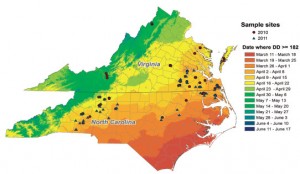Cereal Leaf Beetle Behind Schedule
go.ncsu.edu/readext?287173
en Español / em Português
El inglés es el idioma de control de esta página. En la medida en que haya algún conflicto entre la traducción al inglés y la traducción, el inglés prevalece.
Al hacer clic en el enlace de traducción se activa un servicio de traducción gratuito para convertir la página al español. Al igual que con cualquier traducción por Internet, la conversión no es sensible al contexto y puede que no traduzca el texto en su significado original. NC State Extension no garantiza la exactitud del texto traducido. Por favor, tenga en cuenta que algunas aplicaciones y/o servicios pueden no funcionar como se espera cuando se traducen.
Português
Inglês é o idioma de controle desta página. Na medida que haja algum conflito entre o texto original em Inglês e a tradução, o Inglês prevalece.
Ao clicar no link de tradução, um serviço gratuito de tradução será ativado para converter a página para o Português. Como em qualquer tradução pela internet, a conversão não é sensivel ao contexto e pode não ocorrer a tradução para o significado orginal. O serviço de Extensão da Carolina do Norte (NC State Extension) não garante a exatidão do texto traduzido. Por favor, observe que algumas funções ou serviços podem não funcionar como esperado após a tradução.
English
English is the controlling language of this page. To the extent there is any conflict between the English text and the translation, English controls.
Clicking on the translation link activates a free translation service to convert the page to Spanish. As with any Internet translation, the conversion is not context-sensitive and may not translate the text to its original meaning. NC State Extension does not guarantee the accuracy of the translated text. Please note that some applications and/or services may not function as expected when translated.
Collapse ▲In a previous article I covered the reasons why it would not be a good idea to spray automatically for cereal leaf beetle this year (Reasons You Will Lose Money in 2014 Tank Mixing an Insecticide with Your Nitrogen Over Wheat). To add fuel to that argument, cereal leaf beetle is behind “normal” schedule this year.
The Southern Region IPM Center and NC and VA Small Grains Growers Associations funded a major research and sampling effort in 2010 and 2011. We found that we could accurately predict the peak egg lay of cereal leaf beetle within three days based on a temperature based model. The figure in this article details the time in which the peak egg lay occurred in these studies. This took place at 182 “degree days”. Degree days for cereal leaf beetle are calculated using temperature. The more degree days there are, the warmer it has been and the sooner cereal leaf beetle will emerge. In the study, peak egg lay in Plymouth, NC (182 degree days) occured around the end of March. However, as of 27 March 2014, Plymouth has only received 117 degree days. That means we are 65 degree days away from peak egg lay for cereal leaf beetle in Plymouth in 2014. I confirmed this by walking some wheat this afternoon. Plenty of Hessian fly eggs (two weeks later than last year when I observed eggs – see article), but not a single cereal leaf beetle egg.
It is important to note that insecticides are effective only on the larvae, not the eggs. Larvae tend to peak 2-3 weeks after egg lay. Furthermore, rain and other weather events can kill eggs. It is therefore more critical than ever to hold off insecticide for cereal leaf beetle this year since it is too early and may not be needed.



